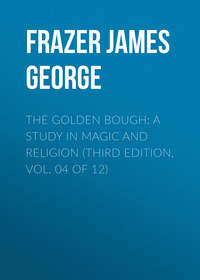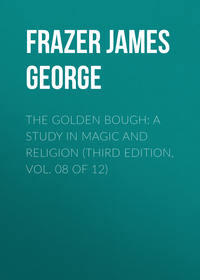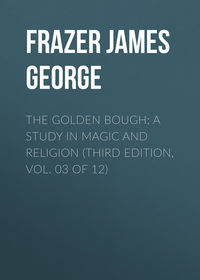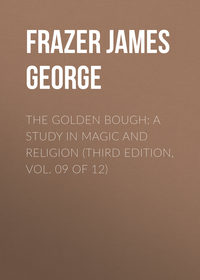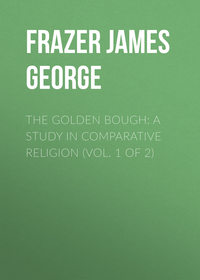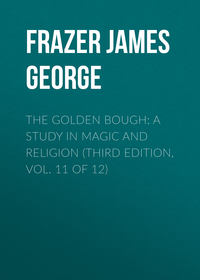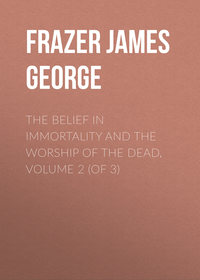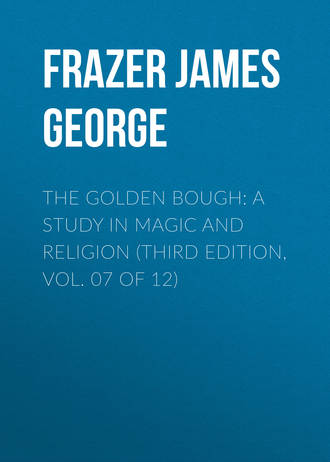 полная версия
полная версияThe Golden Bough: A Study in Magic and Religion (Third Edition, Vol. 07 of 12)
Sacred marriage of Zeus and Demeter at Eleusis. Homer on the love of Zeus for Demeter. Zeus the Sky God may have been confused with Subterranean Zeus, that is, Pluto. Demeter may have been confused with Persephone; in art the types of the two goddesses are often very similar.
In a former part of this work I followed an eminent French scholar in concluding, from various indications, that part of the religious drama performed in the mysteries of Eleusis may have been a marriage between the sky-god Zeus and the corn-goddess Demeter, represented by the hierophant and the priestess of the goddess respectively.231 The conclusion is arrived at by combining a number of passages, all more or less vague and indefinite, of late Christian writers; hence it must remain to some extent uncertain and cannot at the best lay claim to more than a fair degree of probability. It may be, as Professor W. Ridgeway holds, that this dramatic marriage of the god and goddess was an innovation foisted into the Eleusinian Mysteries in that great welter of religions which followed the meeting of the East and the West in the later ages of antiquity.232 If a marriage of Zeus and Demeter did indeed form an important feature of the Mysteries in the fifth century before our era, it is certainly remarkable, as Professor Ridgeway has justly pointed out, that no mention of Zeus occurs in the public decree of that century which regulates the offerings of first-fruits and the sacrifices to be made to the gods and goddesses of Eleusis.233 At the same time we must bear in mind that, if the evidence for the ritual marriage of Zeus and Demeter is late and doubtful, the evidence for the myth is ancient and indubitable. The story was known to Homer, for in the list of beauties to whom he makes Zeus, in a burst of candour, confess that he had lost his too susceptible heart, there occurs the name of “the fair-haired Queen Demeter”;234 and in another passage the poet represents the jealous god smiting with a thunderbolt the favoured lover with whom the goddess had forgotten her dignity among the furrows of a fallow field.235 Moreover, according to one tradition, Dionysus himself was the offspring of the intrigue between Zeus and Demeter.236 Thus there is no intrinsic improbability in the view that one or other of these unedifying incidents in the backstairs chronicle of Olympus should have formed part of the sacred peep-show in the Eleusinian Mysteries. But it seems just possible that the marriage to which the Christian writers allude with malicious joy may after all have been of a more regular and orthodox pattern. We are positively told that the rape of Persephone was acted at the Mysteries;237 may that scene not have been followed by another representing the solemnisation of her nuptials with her ravisher and husband Pluto? It is to be remembered that Pluto was sometimes known as a god of fertility under the title of Subterranean Zeus. It was to him under that title as well as to Demeter, that the Greek ploughman prayed at the beginning of the ploughing;238 and the people of Myconus used to sacrifice to Subterranean Zeus and Subterranean Earth for the prosperity of the crops on the twelfth day of the month Lenaeon.239 Thus it may be that the Zeus whose marriage was dramatically represented at the Mysteries was not the sky-god Zeus, but his brother Zeus of the Underworld, and that the writers who refer to the ceremony have confused the two brothers. This view, if it could be established, would dispose of the difficulty raised by the absence of the name of Zeus in the decree which prescribes the offerings to be made to the gods of Eleusis; for although in that decree Pluto is not mentioned under the name of Subterranean Zeus, he is clearly referred to, as the editors of the inscription have seen, under the vague title of “the God,” while his consort Persephone is similarly referred to under the title of “the Goddess,” and it is ordained that perfect victims shall be sacrificed to both of them. However, if we thus dispose of one difficulty, it must be confessed that in doing so we raise another. For if the bridegroom in the Sacred Marriage at Eleusis was not the sky-god Zeus, but the earth-god Pluto, we seem driven to suppose that, contrary to the opinion of the reverend Christian scandal-mongers, the bride was his lawful wife Persephone and not his sister and mother-in-law Demeter. In short, on the hypothesis which I have suggested we are compelled to conclude that the ancient busybodies who lifted the veil from the mystic marriage were mistaken as to the person both of the divine bridegroom and of the divine bride. In regard to the bridegroom I have conjectured that they may have confused the two brothers, Zeus of the Upper World and Zeus of the Lower World. In regard to the bride, can any reason be suggested for confounding the persons of the mother and daughter? On the view here taken of the nature of Demeter and Persephone nothing could be easier than to confuse them with each other, for both of them were mythical embodiments of the corn, the mother Demeter standing for the old corn of last year and the daughter Persephone standing for the new corn of this year. In point of fact Greek artists, both of the archaic and of later periods, frequently represent the Mother and Daughter side by side in forms which resemble each other so closely that eminent modern experts have sometimes differed from each other on the question, which is Demeter and which is Persephone; indeed in some cases it might be quite impossible to distinguish the two if it were not for the inscriptions attached to the figures.240 The ancient sculptors, vase-painters, and engravers must have had some good reason for portraying the two goddesses in types which are almost indistinguishable from each other; and what better reason could they have had than the knowledge that the two persons of the godhead were one in substance, that they stood merely for two different aspects of the same simple natural phenomenon, the growth of the corn? Thus it is easy to understand why Demeter and Persephone may have been confused in ritual as well as in art, why in particular the part of the divine bride in a Sacred Marriage may sometimes have been assigned to the Mother and sometimes to the Daughter. But all this, I fully admit, is a mere speculation, and I only put it forward as such. We possess far too little information as to a Sacred Marriage in the Eleusinian Mysteries to be justified in speaking with confidence on so obscure a subject.
The date of the Eleusinian Mysteries in September would have been a very appropriate time for a Sacred Marriage of the Sky God with the Corn Goddess or the Earth Goddess.
One thing, however, which we may say with a fair degree of probability is that, if such a marriage did take place at Eleusis, no date in the agricultural year could well have been more appropriate for it than the date at which the Mysteries actually fell, namely about the middle of September. The long Greek summer is practically rainless and in the fervent heat and unbroken drought all nature languishes. The river-beds are dry, the fields parched. The farmer awaits impatiently the setting-in of the autumnal rains, which begin in October and mark the great season for ploughing and sowing. What time could be fitter for celebrating the union of the Corn Goddess with her husband the Earth God or perhaps rather with her paramour the Sky God, who will soon descend in fertilising showers to quicken the seed in the furrows? Such embraces of the divine powers or their human representatives might well be deemed, on the principles of homoeopathic or imitative magic, indispensable to the growth of the crops. At least similar ideas have been entertained and similar customs have been practised by many peoples;241 and in the legend of Demeter's love-adventure among the furrows of the thrice-ploughed fallow242 we seem to catch a glimpse of rude rites of the same sort performed in the fields at sowing-time by Greek ploughmen for the sake of ensuring the growth of the seed which they were about to commit to the bosom of the naked earth. In this connexion a statement of ancient writers as to the rites of Eleusis receives fresh significance. We are told that at these rites the worshippers looked up to the sky and cried “Rain!” and then looked down at the earth and cried “Conceive!”243 Nothing could be more appropriate at a marriage of the Sky God and the Earth or Corn Goddess than such invocations to the heaven to pour down rain and to the earth or the corn to conceive seed under the fertilising shower; in Greece no time could well be more suitable for the utterance of such prayers than just at the date when the Great Mysteries of Eleusis were celebrated, at the end of the long drought of summer and before the first rains of autumn.
The Eleusinian games distinct from the Eleusinian Mysteries. The Eleusinian games of later origin than the Eleusinian Mysteries. The Eleusinian games sacred to Demeter and Persephone. Triptolemus, the mythical hero of the corn.
Different both from the Great Mysteries and the offerings of first-fruits at Eleusis were the games which were celebrated there on a great scale once in every four years and on a less scale once in every two years.244 That the games were distinct from the Mysteries is proved by their periods, which were quadriennial and biennial respectively, whereas the Mysteries were celebrated annually. Moreover, in Greek epigraphy, our most authentic evidence in such matters, the games and the Mysteries are clearly distinguished from each other by being mentioned separately in the same inscription.245 But like the Mysteries the games seem to have been very ancient; for the Parian Chronicler, who wrote in the year 264 b. c., assigns the foundation of the Eleusinian games to the reign of Pandion, the son of Cecrops. However, he represents them as of later origin than the Eleusinian Mysteries, which according to him were instituted by Eumolpus in the reign of Erechtheus, after Demeter had planted corn in Attica and Triptolemus had sown seed in the Rarian plain at Eleusis.246 This testimony to the superior antiquity of the Mysteries is in harmony with our most ancient authority on the rites of Eleusis, the author of the Hymn to Demeter, who describes the origin of the Eleusinian Mysteries, but makes no reference or allusion to the Eleusinian Games. However, the great age of the games is again vouched for at a much later date by the rhetorician Aristides, who even declares that they were the oldest of all Greek games.247 With regard to the nature and meaning of the games our information is extremely scanty, but an old scholiast on Pindar tells us that they were celebrated in honour of Demeter and Persephone as a thank-offering at the conclusion of the corn-harvest.248 His testimony is confirmed by that of the rhetorician Aristides, who mentions the institution of the Eleusinian games in immediate connexion with the offerings of the first-fruits of the corn, which many Greek states sent to Athens;249 and from an inscription dated about the close of the third century before our era we learn that at the Great Eleusinian Games sacrifices were offered to Demeter and Persephone.250 Further, we gather from an official Athenian inscription of 329 b. c. that both the Great and the Lesser Games included athletic and musical contests, a horse-race, and a competition which bore the name of the Ancestral or Hereditary Contest, and which accordingly may well have formed the original kernel of the games.251 Unfortunately nothing is known about this Ancestral Contest. We might be tempted to identify it with the Ancestral Contest included in the Eleusinian Festival of the Threshing-floor,252 which was probably held on the Sacred Threshing-floor of Triptolemus at Eleusis.253 If the identification could be proved, we should have another confirmation of the tradition which connects the games with Demeter and the corn; for according to the prevalent tradition it was to Triptolemus that Demeter first revealed the secret of the corn, and it was he whom she sent out as an itinerant missionary to impart the beneficent discovery of the cereals to all mankind and to teach them to sow the seed.254 On monuments of art, especially in vase-paintings, he is constantly represented along with Demeter in this capacity, holding corn-stalks in his hand and sitting in his car, which is sometimes winged and sometimes drawn by dragons, and from which he is said to have sowed the seed down on the whole world as he sped through the air.255 At Eleusis victims bought with the first-fruits of the wheat and barley were sacrificed to him as well as to Demeter and Persephone.256 In short, if we may judge from the combined testimony of Greek literature and art, Triptolemus was the corn-hero first and foremost. Even beyond the limits of the Greek world, all men, we are told, founded sanctuaries and erected altars in his honour because he had bestowed on them the gift of the corn.257 His very name has been plausibly explained both in ancient and modern times as “Thrice-ploughed” with reference to the Greek custom of ploughing the land thrice a year,258 and the derivation is said to be on philological principles free from objection.259 In fact it would seem as if Triptolemus, like Demeter and Persephone themselves, were a purely mythical being, an embodiment of the conception of the first sower. At all events in the local Eleusinian legend, according to an eminent scholar, who has paid special attention to Attic genealogy, “Triptolemus does not, like his comrade Eumolpus or other founders of Eleusinian priestly families, continue his kind, but without leaving offspring who might perpetuate his priestly office, he is removed from the scene of his beneficent activity. As he appeared, so he vanishes again from the legend, after he has fulfilled his divine mission.”260
Prizes of barley given to victors in the Eleusinian games.
However, there is no sufficient ground for identifying the Ancestral Contest of the Eleusinian games with the Ancestral Contest of the Threshing-festival at Eleusis, and accordingly the connexion of the games with the corn-harvest and with the corn-hero Triptolemus must so far remain uncertain. But a clear trace of such a connexion may be seen in the custom of rewarding the victors in the Eleusinian games with measures of barley; in the official Athenian inscription of 329 b. c., which contains the accounts of the superintendents of Eleusis and the Treasurers of the Two Goddesses, the amounts of corn handed over by these officers to the priests and priestesses for the purposes of the games is exactly specified.261 This of itself is sufficient to prove that the Eleusinian games were closely connected with the worship of Demeter and Persephone. The grain thus distributed in prizes was probably reaped on the Rarian plain near Eleusis, where according to the legend Triptolemus sowed the first corn.262 Certainly we know that the barley grown on that plain was used in sacrifices and for the baking of the sacrificial cakes,263 from which we may reasonably infer that the prizes of barley, to which no doubt a certain sanctity attached in the popular mind, were brought from the same holy fields. So sacred was the Rarian plain that no dead body was allowed to defile it. When such a pollution accidentally took place, it was expiated by the sacrifice of a pig,264 the usual victim employed in Greek purificatory rites.
The Eleusinian games primarily concerned with Demeter and Persephone. The Ancestral Contest in the games may have been originally a contest between the reapers to finish reaping.
Thus, so far as the scanty evidence at our disposal permits us to judge, the Eleusinian games, like the Eleusinian Mysteries, would seem to have been primarily concerned with Demeter and Persephone as goddesses of the corn. At least that is expressly affirmed by the old scholiast on Pindar and it is borne out by the practice of rewarding the victors with measures of barley. Perhaps the Ancestral Contest, which may well have formed the original nucleus of the games, was a contest between the reapers on the sacred Rarian plain to see who should finish his allotted task before his fellows. For success in such a contest no prize could be more appropriate than a measure of the sacred barley which the victorious reaper had just cut on the barley-field. In the sequel we shall see that similar contests between reapers have been common on the harvest fields of modern Europe, and it will appear that such competitions are not purely athletic; their aim is not simply to demonstrate the superior strength, activity, and skill of the victors; it is to secure for the particular farm the possession of the blooming young Corn-maiden of the present year, conceived as the embodiment of the vigorous grain, and to pass on to laggard neighbours the aged Corn-mother of the past year, conceived as an embodiment of the effete and outworn energies of the corn.265 May it not have been so at Eleusis? may not the reapers have vied with each other for possession of the young corn-spirit Persephone and for avoidance of the old corn-spirit Demeter? may not the prize of barley, which rewarded the victor in the Ancestral Contest, have been supposed to house in the ripe ears no less a personage than the Corn-maiden Persephone herself? And if there is any truth in these conjectures (for conjectures they are and nothing more), we may hazard a guess as to the other Ancestral Contest which took place at the Eleusinian Festival of the Threshing-floor. Perhaps it in like manner was originally a competition between threshers on the sacred threshing-floor of Triptolemus to determine who should finish threshing his allotted quantity of corn before the rest. Such competitions have also been common, as we shall see presently, on the threshing-floors of modern Europe, and their motive again has not been simple emulation between sturdy swains for the reward of strength and dexterity; it has been a dread of being burdened with the aged and outworn spirit of the corn conceived as present in the bundle of corn-stalks which receives the last stroke at threshing.266 We know that effigies of Demeter with corn and poppies in her hands stood on Greek threshing-floors.267 Perhaps at the conclusion of the threshing these effigies, as representatives of the old Corn-spirit, were passed on to neighbours who had not yet finished threshing the corn. At least the supposition is in harmony with modern customs observed on the threshing-floor.
Games at harvest festivals in modern Europe.
It is possible that the Eleusinian games were no more than a popular merrymaking celebrated at the close of the harvest. This view of their character might be supported by modern analogies; for in some parts of Germany it has been customary for the harvesters, when their work is done, to engage in athletic competitions of various kinds, which have at first sight no very obvious connexion with the business of harvesting. For example, at Besbau near Luckau great cakes were baked at the harvest-festival, and the labourers, both men and women, ran races for them. He or she who reached them first received not only a cake, but a handkerchief or the like as a prize. Again, at Bergkirchen, when the harvest was over, a garland was hung up and the harvesters rode at it on horseback and tried to bring it down with a stab or a blow as they galloped past. He who succeeded in bringing it down was proclaimed King. Again, in the villages near Fürstenwald at harvest the young men used to fetch a fir-tree from the wood, peel the trunk, and set it up like a mast in the middle of the village. A handkerchief and other prizes were fastened to the top of the pole and the men clambered up for them.268 Among the peasantry of Silesia, we are told, the harvest-home broadened out into a popular festival, in which athletic sports figured prominently. Thus, for example, at Järischau, in the Strehlitz district, a scythe, a rake, a flail, and a hay-fork or pitchfork were fastened to the top of a smooth pole and awarded as prizes, in order of merit, to the men who displayed most agility in climbing the pole. Younger men amused themselves with running in sacks, high jumps, and so forth. At Prauss, near Nimptsch, the girls ran a race in a field for aprons as prizes. In the central parts of Silesia a favourite amusement at harvest was a race between girls for a garland of leaves or flowers.269 Yet it seems probable that all such sports at harvest were in origin not mere pastimes, but that they were serious attempts to secure in one way or another the help and blessing of the corn-spirit. Thus in some parts of Prussia, at the close of the rye-harvest, a few sheaves used to be left standing in the field after all the rest of the rye had been carted home. These sheaves were then made up into the shape of a man and dressed out in masculine costume, and all the young women were obliged to run a race, of which the corn-man was the goal. She who won the race led off the dancing in the evening.270 Here the aim of the foot-race among the young women is clearly to secure the corn-spirit embodied in the last sheaf left standing on the field; for, as we shall see later on, the last sheaf is commonly supposed to harbour the corn-spirit and is treated accordingly like a man or a woman.271
Date of the Eleusinian games uncertain.
If the Ancestral Contest at the Eleusinian games was, as I have conjectured, a contest between the reapers on the sacred barley-field, we should have to suppose that the games were celebrated at barley-harvest, which in the lowlands of Greece falls in May or even at the end of April. This theory is in harmony with the evidence of the scholiast on Pindar, who tells us that the Eleusinian games were celebrated after the corn-harvest.272 No other ancient authority, so far as I am aware, mentions at what time of the year these games were held. Modern authorities, arguing from certain slight and to some extent conjectural data, have variously assigned them to Metageitnion (August) and to Boedromion (September), and those who assign them to Boedromion (September) are divided in opinion as to whether they preceded or followed the Mysteries.273 However, the evidence is far too slender and uncertain to allow of any conclusions being based on it.
Why should games intended to promote the annual growth of the crops be held only every second or fourth year? The Eleusinian Mysteries probably much older than the Eleusinian games.
But there is a serious difficulty in the way of connecting the Eleusinian games with the goddesses of the corn. How is the quadriennial or the biennial period of the games to be reconciled with the annual growth of the crops? Year by year the barley and the wheat are sown and reaped; how then could the games, held only every fourth or every second year, have been regarded as thank-offerings for the annual harvest? On this view of their nature, which is the one taken by the old scholiast on Pindar, though the harvest was received at the hands of the Corn Goddess punctually every year, men thanked her for her bounty only every second year or even only every fourth year. What were her feelings likely to be in the blank years when she got no thanks and no games? She might naturally resent such negligence and ingratitude and punish them by forbidding the seed to sprout, just as she did at Eleusis when she mourned the loss of her daughter. In short, men could hardly expect to reap crops in years in which they offered nothing to the Corn Goddess. That would indeed appear to be the view generally taken by the ancient Greeks; for we have seen that year by year they presented the first-fruits of the barley and the wheat to Demeter, not merely in the solemn state ritual of Eleusis, but also in rustic festivals held by farmers on their threshing-floors. The pious Greek husbandman would no doubt have been shocked and horrified at a proposal to pay the Corn Goddess her dues only every second or fourth year. “No offerings, no crops,” he would say to himself, and would anticipate nothing but dearth and famine in any year when he failed to satisfy the just and lawful demands of the divinity on whose good pleasure he believed the growth of the corn to be directly dependent. Accordingly we may regard it as highly probable that from the very beginning of settled and regular agriculture in Greece men annually propitiated the deities of the corn with a ritual of some sort, and rendered them their dues in the shape of offerings of the ripe barley and wheat. Now we know that the Mysteries of Eleusis were celebrated every year, and accordingly, if I am right in interpreting them as essentially a dramatic representation of the annual vicissitudes of the corn performed for the purpose of quickening the seed, it becomes probable that in some form or another they were annually held at Eleusis long before the practice arose of celebrating games there every fourth or every second year. In short, the Eleusinian mysteries were in all probability far older than the Eleusinian games. How old they were we cannot even guess. But when we consider that the cultivation of barley and wheat, the two cereals specially associated with Demeter, appears to have been practised in prehistoric Europe from the Stone Age onwards,274 we shall be disposed to admit that the annual performance of religious or magical rites at Eleusis for the purpose of ensuring good crops, whether by propitiating the Corn Goddess with offerings of first-fruits or by dramatically representing the sowing and the growth of the corn in mythical form, probably dates from an extremely remote antiquity.




